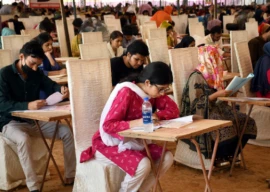
Financial difficulties at the Sindh Education Foundation’s (SEF) latest initiative, the Integrated Education Learning Project (IELP), have worried school administrators from Jamshoro to Dadu, who fear that they would have to decrease enrolment to meet their monthly bills.
The SEF is a semi-autonomous body, whose initiatives are jointly financed by the Sindh government and private organisations.
Partly funded by the Sindh government and the World Bank, the SEF had launched the Rs2.1-billion IELP programme for a period of two years in 2010. Over 250,000 students, between the ages of five to 18 years, were provided subsidised education as part of the programme. The students were given financial assistance of up to Rs350 every month, while they were provided books, school bags and uniforms for free.
Impressed by the results by the time the project ended in June 2012, the Sindh government had reportedly promised that it would make it permanent.
The project had a network of over 1,250 private schools across the province, said SEF director Aziz Kabani. “The government spends at least Rs2,500 on a single student at public schools every month. But IELP schools spent around one sixth of that,” said Ibrahim Maznani, whose nonprofit organisation, Community Development Council, opened 68 schools in mountainous, forested and riverside areas of Dadu and Jamshoro districts. Over the past two years, enrolment at these schools had shot up to 12,543 students.

“We opened schools in remote villages, including Manchar Lake, Kharo Chann, Nangar Parkar, Hamal Lake and Rehri, where generations of residents had been deprived of education,” said Maznani.
His non-profit group even set up two boat schools, on Manchar Lake’s Muhammad Khan Mallah boat village, where 185 children are currently studying. “We also hired small boats for transporting teachers and students who live in distant areas of the huge lake.”
However, Maznani said that it was increasingly becoming hard for school operators like him to continue to manage the schools without a financial boost from the SEF. “A drop in enrolment is inevitable without the [government’s] support.”
Mumtaz Ali, who operates six schools in Khuda Ki Basti, Karo Khooh and Kaiseri Bagh areas of Jamshoro, said that he had received Rs1.86 million, in multiple instalments, from the SEF for the 870 of his students. The last instalment was released in June 2012, which was intended to meet expenditures for the next three months.
School operators had been reportedly assured that the programme would be extended for another four years at the project’s concluding ceremony last June. An extension was also considered as an implicit acknowledgement by the government that it would continue to supply its share of funds.
“We still have around five million children who are out of school, and we cannot afford to keep this project up and running,” said Kabani, the SEF director. He added that during a board of governors meeting last August, Sindh Education Minister Pir Mazharul Haq and other officials had decided to make IELP a permanent programme. However, eight months on, Kabani is still not sure when that would come to pass.
Published in The Express Tribune, February 11th, 2013.

1726117332-0/Megan-Thee-Stallion-(1)1726117332-0-165x106.webp)





















COMMENTS
Comments are moderated and generally will be posted if they are on-topic and not abusive.
For more information, please see our Comments FAQ